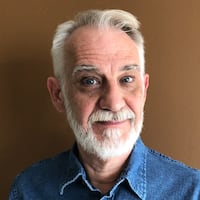On Friday, Oct. 16, Murdock, the Troutman family, Mayor Nan Whaley and others gathered for a small public dedication for a new Ohio Historic Marker and musical sculpture by local artist Michael Bashaw.
“I always felt that was sacred ground because of all the music that came out of there, my own music included,” Murdock said. “People from all over Dayton recorded there. I was blessed to be involved in bringing the musical statue to fruition and the marker was an added bonus. I applaud these young ladies for the work they’ve done and how diligently they worked to bring it all together. I was very honored to be a part of it.”
Lester Troutman still heads up Zapp, the funk band his brothers formed in Dayton in the 1970s. He shares Murdock’s sentiments.
“I’m just blown away,” Lester Troutman said. "I wish my brothers were here but since they’re not, I’m going to speak on their behalf based on the conversations we had as kids and young men. We’ve always put our hearts into what we’ve done and put our best foot forward every time we set out to do something. Sometimes we stayed up weeks, days and months to make the sounds we created but we never knew they were going to touch young people around the world the way that they did.
“For my brothers and the rest of my family, we are purely honored Miss Boroff and Miss Hudson took just a few moments to look back and listen to some of the things we did,” he added. “It’s truly mind-blowing.”
MUSICAL LEGACY
Zapp, originally known as Roger and the Human Body, released its self-titled debut on Warner Brothers in 1980. It reached number one on Billboard’s R&B album chart. It went gold as did the follow-ups “Zapp II” (1982), “Zapp III” (1983) and “The New Zapp 4U” (1985). This was a prolific period for Roger, who released solo albums on Warner Brothers on alternate years such as “The Many Facets of Roger” (1981) and “The Saga Continues” (1984).
Roger and Zapp both moved to Reprise, which released the solo albums “Unlimited!” (1987) and “Bridging the Gap” (1991) and the group’s “Zapp Vibe” (1989).
The Troutman sound was embraced in the 1990s by some of the biggest names in hip-hop. In addition to rap producers sampling the group’s recordings, Roger also appeared on Snoop Dogg’s “Doggystyle” (1993), “California Love” by 2Pac and Dr. Dre (1995) and Kool Keith’s “Master of the Game” (1999).
OHIO HISTORY
The Ohio Historic Marker for Troutman Sound Labs was spearheaded by Bowling Green State University students Jacqueline Hudson and Kari Boroff.
“The professor for our Museology class wanted everybody to partner up and create a hypothetical proposal for a marker,” Boroff said. “She wanted us to go through the process of what it’s like to create a historical space in the State of Ohio. We both love music and music is very underrepresented with the Ohio Historic Markers so we were trying to figure out where to go with this project. I knew Dayton has a rich history in funk music and my husband told me about Troutman Sound Labs.”
While the project started as an assignment, Hudson and Boroff decided to bring it to life outside of the classroom. The historic marker became a reality with assistance from the Ohio History Connection and financial support from the Levin Family Foundation.
“Kari and I had a lot of help on this,” Hudson said. “I’d like to give a shoutout to Holly Kirkendall, our Museology instructor, for presenting the assignment to us. It was the school project that inspired this and helped it come to fruition. We learn through books and assignments but I’m always a firm believer that doing the work itself is the best teacher. I never thought I’d know about zoning or grant writing but I learned about it through hands-on experience.”
For Murdock, who recorded her gold-selling self-titled album at Troutman Sound Labs in 1987, this is an honor that is long past due.
“It’s something that is well deserved,” she said. "I’m very, very honored, happy and thankful these young ladies had the heart to want to do it because they could’ve done a marker for anything in Ohio. They have a love of music and an appreciation for what the Troutman brothers did right there on that corner and I’m elated about it.
“I want to continue to keep the music alive,” Murdock added. “I want to keep the legacy alive so when Roger’s children and his children’s children come to that corner, it will not be remembered just for the tragedy but it will also be remembered for all of the great things that came out of there.”
Contact contributing arts and music writer Don Thrasher at donthrasher100@gmail.com.
About the Author





